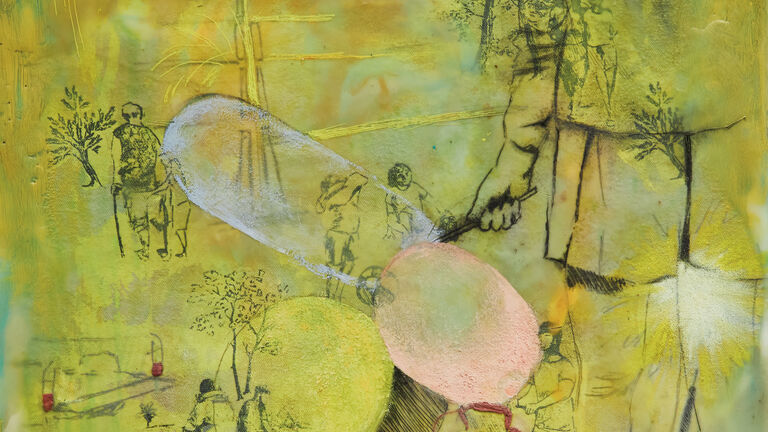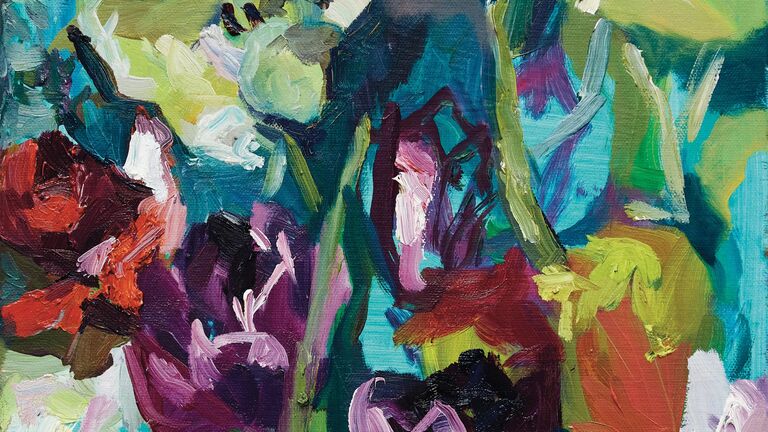
Ruth L Poor, "Some Tailgate," 2021
Undergraduate Overview
Painting and Drawing Undergraduate Overview
With up to 80 courses offered in the Department of Painting and Drawing at the School of the Art Institute of Chicago (SAIC) each semester, students have the choice, freedom, and openness to design a painting and drawing curriculum tailored to their creative needs while developing the skills and conceptual foundations necessary for a sustainable art practice.
Choose from:
1. Painting Practice Classes: This is an introductory prerequisite course for all other painting classes. It is taught by a variety of faculty, each with their own pedagogical approach. Students learn the fundamentals of painting with a strong emphasis on developing proficiency with fundamental formal and material processes. Students also become familiar with various forms of visual and critical engagement in order to catalyze their conceptual development.
2. Painting Studio: Multi-Level Classes: These classes offer a fertile environment for the development of individual practice while advancing technical skill. General sections are open to students who have completed Painting Practice. Advanced, topic-based sections are also available. Topics include but are not limited to:
- The Abstract Image
- Cheap TV
- Conceptual Approach
- The Dream
- Exploding Paint
- Expressionism
- Funny Painting
- Painting after Painting
3. Studio Drawing: Multi-Level Classes: Taught by a diverse group of faculty who approach drawing with critical rigor, students learn and develop drawing fundamentals, as well as explore experimental, narrative and conceptual approaches with different media. General sections, as well as specialized, topic-based sections are available without prerequisite course requirements. Topics include, but are not limited to:
- Wild Combination
- Mixed Media
- Abstraction/Representation
- Ink Painting: the Brush of Zen
- Large Format Painting
- Collage: Concepts and Techniques
- Landscape Narratives
Figure Drawing and Painting Classes
Dedicated to the study of the body, these classes prioritize various approaches to the line, shape, volume, and anatomy of the human form. Approaches range from perceptually traditional to radically conceptual. Topics include but are not limited to:
- Anatomy
- Figures in Space
- Large Format
- The Portrait
- Advanced: Inside and Out
- Advanced: Narrative Figuration
- Advanced: Photo to Memory
Materials and Techniques Classes
These classes, offered in our new state of the art StudioLab, focus on the production, preparation and application of various traditional and contemporary paint systems. Students have the opportunity to make their own paints and drawing materials, such as egg tempera, gesso, casein, encaustic, oil paint, advanced acrylic processes, as well as silverpoint, conte-crayon and walnut ink. Students are also encouraged to develop their own material processes and recipes.
Comics Classes
These courses, taught in classrooms dedicated to the specific needs of comic production, cover aspects of narrative development, cell layout, illustration, zine creation and a variety of other approaches. Topics include but are not limited to:
- Autobiography
- Advanced Comics
- Capstone: Publish or Perish
- Cartooning the Figure
- Drawing Outside the Boxes
- Independent Comics
Sophomore Seminars, Professional Practices, and Senior Capstone Classes
The Academic Spine is a required three-course sequence for all undergraduate degrees. The three courses provide a structure of peer support and intensive faculty mentoring as students navigate SAIC’s open curriculum. Please see here for more information.
Advanced Painting Studio: Each semester, advanced students can apply to one of two sections of Advanced Painting Studio. Students share dedicated, private studio spaces from one to three consecutive semesters, working with faculty members three days per week. In many ways, this highly competitive course begins to approach the intensity of a graduate program, requiring dedicated independent studio practice and rigorous conceptual development.
Summer Institute: Painting Residency/Drawing Residency: These three-week summer intensives are taught in the Advanced Painting studios. Offering a residency experience, students are provided with an individual studio space, instruction from two faculty members, and access to an established visiting artist-in-residence who works alongside the students. While studio practice is primary, topical lectures and periodic visits to the Art Institute of Chicago are a consistent attribute of the course.
Recent Visiting Artists-in-Residence include:
- Kristin Calabrese
- Michael Cline
- Dana DeGuilio
- Karen Heagle
- Salomon Huerta
- Jessica Jackson Hutchins
- Diego Leclery
- Rebecca Morgan
- Ralph Pugay
- Christine Tien Wang
Admissions Requirements & Curriculum Overview
-
To apply to the School of the Art Institute of Chicago (SAIC), you will need to fill out an application and submit your transcripts, artist's statement, and letters of recommendation. And most importantly, we require a portfolio of your best and most recent work—work that will give us a sense of you, your interests, and your willingness to explore, experiment, and think beyond technical art, design, and writing skills.
In order to apply, please submit the following items:
Bachelor of Fine Arts in Studio Portfolio
Submit 10–15 pieces of your best and most recent work. We will review your portfolio and application materials for merit scholarship once you have been admitted to SAIC.When compiling a portfolio, you may concentrate your work in a single discipline or show work in a breadth of media. The portfolio may include drawings, prints, photographs, paintings, film, video, audio recordings, sculpture, ceramics, fashion designs, graphic design, furniture, objects, architectural designs, websites, video games, sketchbooks, scripts, storyboards, screenplays, zines, or any combination of the above.
-
Studio
69
- CP 1010 Core Studio Practice I (3)
- CP 1011 Core Studio Practice II (3)
- CP 1020 Research Studio I (3)
- CP 1022 Research Studio II (3)
- SOPHSEM 2900 (3)
- PROFPRAC 3900 (3)
- CAPSTONE 4900 (3)
- Studio Electives (48)
PROFPRAC and CAPSTONE are now required for new incoming students beginning in the 2015-16 academic year.
Art History
15
- ARTHI 1001 World Cultures/Civilizations: Pre-History—19th Century Art and Architecture (3)
- Art History Elective at 1000 level (3)
- Art History Electives (9)
Liberal Arts
30
- ENGLISH 1001 First Year Seminar I (3)
- ENGLISH 1005 First Year Seminar II (3)
- Natural Science (6)
- Social Science (6)
- Humanities (6)
- Liberal Arts Electives (6)
General Electives
6
- Studio, Art History, Liberal Arts, AAP, or EIS
Total Credit Hours
120
* BFA students must complete at least 6 credit hours in a class designated as "off campus study." These credits can also fulfill any of the requirements listed above and be from any of the divisions (Art History, Studio, Liberal Arts, or General Electives).
BFA With Distinction—SAIC Scholars Program: The SAIC Scholars program is a learning community of BFA students pursuing rigorous study in both their academic coursework and their studio pathways. There are two opportunities for interested students to apply to the SAIC Scholars Program: at the time of admission to the school, and after they have completed 30 credits of study at SAIC. Students pursuing the latter option are required to formally submit an application to the Undergraduate Division. Once admitted to the SAIC Scholars Program, students are required to successfully complete a minimum of six designated scholars courses. Students who complete the program will graduate with distinction.
BFA in Studio with Thesis Option (Liberal Arts or Visual Critical Studies)
BFA students may complete a nine-credit, research-based academic thesis as part of their studies within the 126 credits for the BFA in Studio degree. BFA with Thesis course sequences are offered over 3 semesters through the departments of Liberal Arts or Visual and Critical Studies (VCS). Students who are interested in one of the thesis options should follow the steps outlined below in the beginning of the junior year.
Requirements for the BFA: Studio Art with Liberal Arts Thesis
Step One: Students are required to meet with the Chair of the Liberal Arts department in the beginning of their junior year.
Step Two: With the Department Chair's approval, the student enrolls in the following courses beginning in the spring term of their junior year:
- SOCSCI or HUMANITY 3900 Academic Research and Writing (3 credits)
- LIBARTS 4800 Undergraduate Thesis: Research/Writing I (3 credits)
- CAPSTONE 4900 Liberal Arts Undergraduate Thesis: Research/Writing II (3 credits)
Step Three: The completed thesis must be approved by both the Thesis II instructor and the Chair of Liberal Arts. Students must make a formal presentation and participate in the Undergraduate Thesis Symposium in their senior year.
Requirements for the BFA: Studio Art with Visual and Critical Studies (VCS) Thesis
Step One: Students are required to meet with the Visual and Critical Studies Undergraduate Coordinator in or by the beginning of their junior year.
Step Two: With the VCS Coordinator's approval, the student enrolls in the first of the three-course sequence beginning in the spring term of their junior year:
- VCS 3010 Tutorial in Visual & Critical Studies (3 credits)
- VCS 4800 Undergraduate Thesis Seminar: Research & Writing I (3 credits)
- CAPSTONE 4900 VCS Undergraduate Thesis Seminar: Research & Writing II (3 credits)
Step Three: Completion of thesis must be approved by both the Thesis II instructor and the VCS Undergraduate Coordinator. Students must make a formal presentation and participate in the Undergraduate VCS Thesis Symposium in the senior year.
Total credits required for minimum residency
66
Minimum Studio credit
42
Learn more about applying to SAIC's Bachelor of Fine Arts in Studio, or view our portfolio preparation guide for more information.
Course Listing
Take the Next Step
Visit the undergraduate admissions website or contact the undergraduate admissions office at 800.232.7242 or ugadmiss@saic.edu.
